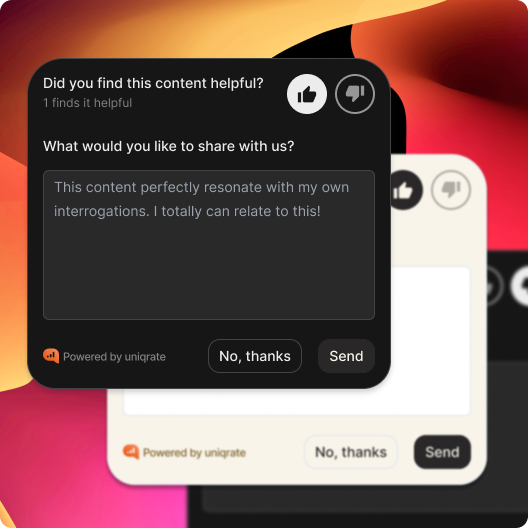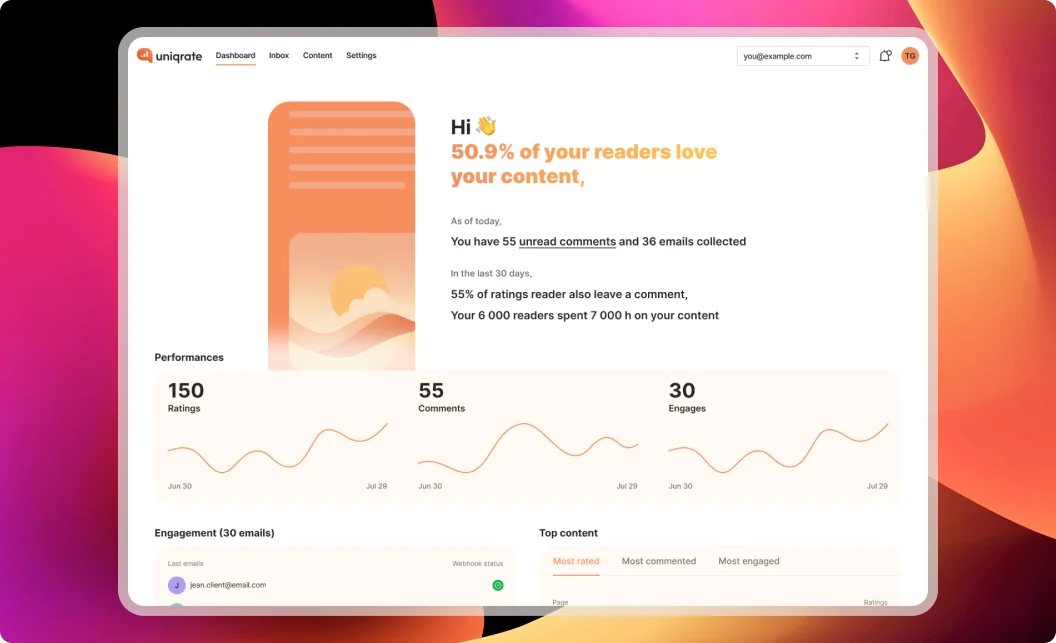A high bounce rate or low time spent on your B2B blog articles can significantly hinder your ability to attract, engage, and convert potential leads. These metrics are critical indicators of how well your content resonates with your audience and whether your blog is successfully guiding readers through the customer journey.
In this article, we’ll explore actionable strategies to address these issues, focusing on improving user experience (UX), leveraging feedback tools, incorporating social proof, and enhancing content quality.
Why bounce rate and time spent matter for B2B blogs
- Bounce rate: Measures the percentage of visitors who leave after viewing just one page. A high bounce rate often means your content isn’t engaging or relevant enough to encourage further exploration.
- Time spent on page: Reflects how long readers stay on your article. Low time spent suggests that your content isn’t holding their attention or providing enough value.
For B2B blogs, where the goal is often lead generation or nurturing, these metrics are crucial for driving conversions.
Strategies to fix high bounce rate and increase time spent
1. Remove cookie banners to improve UX
Cookie banners, while necessary for compliance in some tools, often create friction for readers. These pop-ups can frustrate visitors, interrupt their reading experience, and increase the likelihood of bouncing.
Solution: Go cookie-free
- Use a privacy-friendly, cookie-free analytics tool like Uniqrate.
- Removing cookie banners streamlines your blog’s experience and eliminates distractions that deter visitors from engaging with your content.
By offering a seamless entry to your blog, you encourage readers to stay longer and explore more.
2. Add a feedback tool to engage readers
Engaging readers directly through feedback tools not only improves interaction but also provides valuable insights into what your audience wants.
Benefits of a feedback tool:
- Gather article ideas: Use feedback to understand what topics your readers are most interested in.
- Improve existing content: Identify areas where readers feel your content is lacking or unclear.
- Boost engagement: Feedback tools create a two-way interaction, keeping readers invested in your blog.
How to implement it:
Add an interactive feedback tool like Uniqrate’s island, which allows readers to:
- Vote on how helpful the article is.
- Leave comments or suggestions.
- Provide their email in exchange for a resource, like a whitepaper, turning engagement into lead generation.

3. Incorporate social proof to build trust
B2B audiences prioritize credibility. Social proof—such as user ratings, testimonials, or engagement metrics—helps establish your authority and encourages visitors to spend more time on your blog.
Examples of social proof:
- Display metrics like “500 readers found this article helpful” on your blog posts.
- Include testimonials from satisfied customers or partners.
- Highlight case studies or success stories relevant to your audience.
How to use Uniqrate for social proof:
- Automatically show engagement stats like reader votes or comments to reinforce the value of your content.
4. Enhance content quality to reduce bounce rate
Richer, higher-quality content keeps readers engaged and reduces bounce rates. Poor-quality content, on the other hand, drives visitors away and harms your blog’s reputation.
Steps to enhance content quality:
- Add depth: Provide actionable insights, detailed explanations, and practical examples tailored to your audience’s needs.
- Use visuals: Break up text with infographics, charts, or videos to make your articles more engaging.
- Write for readability: Use short paragraphs, bullet points, and subheadings to make your content easy to digest.
Detect low-quality content early:
Leverage feedback and analytics tools to identify underperforming articles. If a blog post receives low engagement or feedback, prioritize improving or rewriting it.
5. Guide readers with clear calls-to-action (CTAs)
Once readers are engaged, guide them toward the next step in their journey. Ambiguous or absent CTAs can leave visitors unsure of what to do, resulting in higher bounce rates.
Tips for effective CTAs:
- Place CTAs at logical points within the article, such as after key insights or at the conclusion.
- Use actionable language like “Download our free guide” or “Explore our case studies.”
- Ensure CTAs are visually distinct and easy to click.
6. Encourage deeper exploration through internal linking
Encouraging visitors to explore more of your blog is an effective way to reduce bounce rates and increase time spent.
Best practices for internal linking:
- Link to related articles or resources within your content.
- Highlight popular or recently published posts in a sidebar or footer.
- Use anchor text that clearly indicates the value of the linked content.
Example: If your blog post is about “B2B Marketing Strategies,” link to related topics like “How to Generate Leads with Content Marketing” or “Optimizing Your Sales Funnel.”
7. Analyze and optimize based on user data
To effectively reduce bounce rates and increase time spent, regularly review your blog’s performance metrics.
Key metrics to monitor:
- Bounce rate per article: Identify which posts are underperforming.
- Time on page: Determine if readers are engaging with your content.
- Feedback trends: Use tools like Uniqrate to gather direct insights from readers.
How Uniqrate can help:
- Provide detailed feedback on content performance.
- Highlight user preferences and areas for improvement.
- Display reader engagement stats to guide content optimization.

Conclusion
Fixing a high bounce rate or low time spent on your B2B blog articles requires a combination of improving user experience, enhancing content quality, and leveraging tools like feedback platforms and social proof.
By removing barriers like cookie banners, adding interactive engagement tools, and focusing on richer, more relevant content, you can create a blog that keeps readers engaged and encourages them to explore further. Over time, these efforts will not only improve your metrics but also help turn your blog into a valuable asset for lead generation and business growth.
